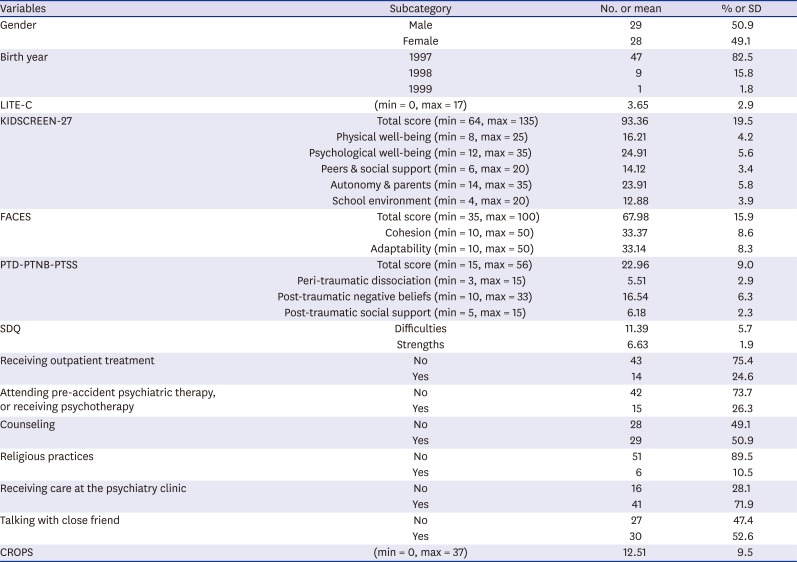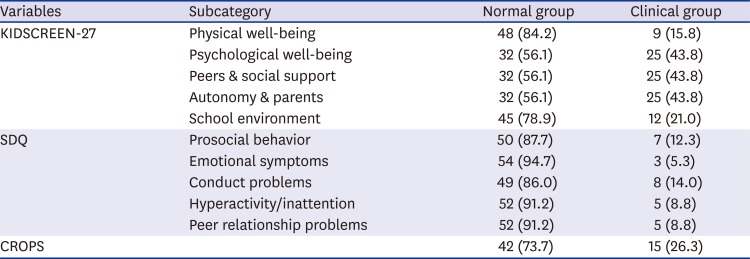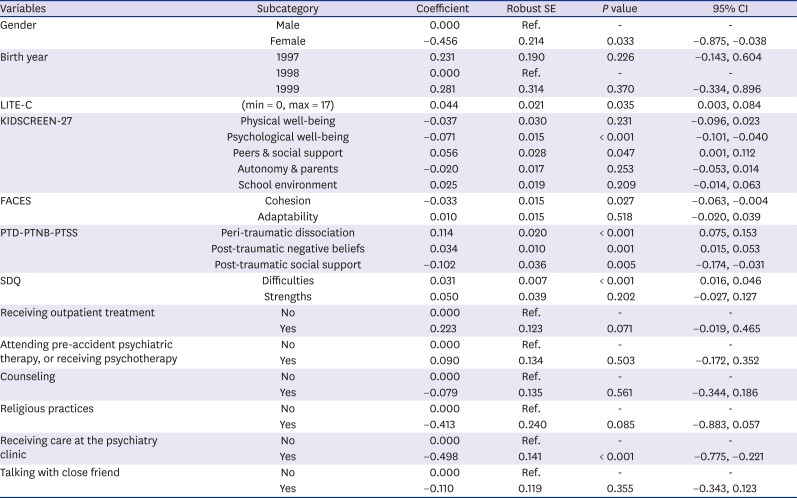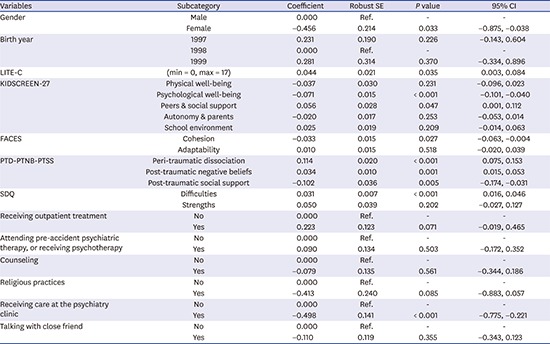1. Sungur M, Kaya B. The onset and longitudinal course of a man-made post-traumatic morbidity: survivors of the Sivas disaster. Int J Psychiatry Clin Pract. 2001; 5(3):195–202. PMID:
24926753.
2. North CS, Smith EM, Spitznagel EL. Posttraumatic stress disorder in survivors of a mass shooting. Am J Psychiatry. 1994; 151(1):82–88.
3. Neria Y, Nandi A, Galea S. Post-traumatic stress disorder following disasters: a systematic review. Psychol Med. 2008; 38(4):467–480. PMID:
17803838.

4. Thompson-Hollands J, Jun JJ, Sloan DM. The association between peritraumatic dissociation and PTSD symptoms: the mediating role of negative beliefs about the self. J Trauma Stress. 2017; 30(2):190–194. PMID:
28449364.

5. Alisic E, van der Schoot TA, van Ginkel JR, Kleber RJ. Looking beyond posttraumatic stress disorder in children: posttraumatic stress reactions, posttraumatic growth, and quality of life in a general population sample. J Clin Psychiatry. 2008; 69(9):1455–1461. PMID:
19193345.
6. Tsai J, Harpaz-Rotem I, Pietrzak RH, Southwick SM. The role of coping, resilience, and social support in mediating the relation between PTSD and social functioning in veterans returning from Iraq and Afghanistan. Psychiatry. 2012; 75(2):135–149. PMID:
22642433.

7. Ehlers A, Clark DM. A cognitive model of posttraumatic stress disorder. Behav Res Ther. 2000; 38(4):319–345. PMID:
10761279.

8. Greenwald R, Rubin A. Assessment of posttraumatic symptoms in children: development and preliminary validation of parent and child scales. Res Soc Work Pract. 1999; 9(1):61–75.

9. Lee KM, Jeong SH, Lee WK, Chung US. Reliability and validity of the Korean version of the child report of post-traumatic symptoms (CROPS) and the parent report of post-traumatic symptoms (PROPS). J Korean Acad Child Adolesc Psychiatry. 2011; 22(3):169–181.

10. Prigerson HG, Maciejewski PK, Reynolds CF 3rd, Bierhals AJ, Newsom JT, Fasiczka A, et al. Inventory of complicated grief: a scale to measure maladaptive symptoms of loss. Psychiatry Res. 1995; 59(1-2):65–79. PMID:
8771222.

11. Ravens-Sieberer U, Auquier P, Erhart M, Gosch A, Rajmil L, Bruil J, et al. The KIDSCREEN-27 quality of life measure for children and adolescents: psychometric results from a cross-cultural survey in 13 European countries. Qual Life Res. 2007; 16(8):1347–1356. PMID:
17668292.

12. Olson DH. FACES III (Family Adaptation and Cohesion Scales). St. Paul, MN: University of Minnesota;1985.
13. Joo HS, Ahn HN. Development and validation of posttrauma risk checklist, Korean. Korean J Psychol Gen. 2008; 27(1):235–257.
14. Kim MH, Ahn JS, Min S. Psychometric properties of the self-report version of the strengths and difficulties questionnaire in Korea. Psychiatry Investig. 2015; 12(4):491–499.

15. Liang KY, Zeger SL. Longitudinal data analysis using generalized linear models. Biometrika. 1986; 73(1):13–22.

16. Lee JY, Kim SW, Bae KY, Kim JM, Shin IS, Yoon JS. Factors associated with posttraumatic stress disorder symptoms among community volunteers during the Sewol ferry disaster in Korea. Compr Psychiatry. 2017; 77(1):38–44. PMID:
28605622.

17. Huh HJ, Huh S, Lee SH, Chae JH. Unresolved bereavement and other mental health problems in parents of the sewol ferry accident after 18 months. Psychiatry Investig. 2017; 14(3):231–239.

18. Lee JY, Kim SW, Bae KY, Kim JM, Shin IS, Yoon JS. Factors associated with post-traumatic stress symptoms among adolescents exposed to the Sewol ferry disaster in Korea. Psychiatry Res. 2017; 256(1):391–395. PMID:
28689142.

19. Dai W, Chen L, Lai Z, Li Y, Wang J, Liu A. The incidence of post-traumatic stress disorder among survivors after earthquakes:a systematic review and meta-analysis. BMC Psychiatry. 2016; 16(1):188. PMID:
27267874.

20. McDonald CC, Deatrick JA. The role of family phenomena in posttraumatic stress in youth. J Child Adolesc Psychiatr Nurs. 2011; 24(1):38–50. PMID:
21344778.

21. Zerach G, Solomon Z, Horesh D, Ein-Dor T. Family cohesion and posttraumatic intrusion and avoidance among war veterans: a 20-year longitudinal study. Soc Psychiatry Psychiatr Epidemiol. 2013; 48(2):205–214. PMID:
22752110.

22. Dai W, Kaminga AC, Tan H, Wang J, Lai Z, Wu X, et al. Long-term psychological outcomes of flood survivors of hard-hit areas of the 1998 Dongting Lake flood in China: prevalence and risk factors. PLoS One. 2017; 12(2):e0171557. PMID:
28170427.

23. Udwin O, Boyle S, Yule W, Bolton D, O'Ryan D. Risk factors for long-term psychological effects of a disaster experienced in adolescence: predictors of post traumatic stress disorder. J Child Psychol Psychiatry. 2000; 41(8):969–979. PMID:
11099114.

24. Han H, Noh JW, Huh HJ, Huh S, Joo JY, Hong JH, et al. Effects of mental health support on the grief of bereaved people caused by sewol ferry accident. J Korean Med Sci. 2017; 32(7):1173–1180. PMID:
28581276.








 PDF
PDF Citation
Citation Print
Print




 XML Download
XML Download